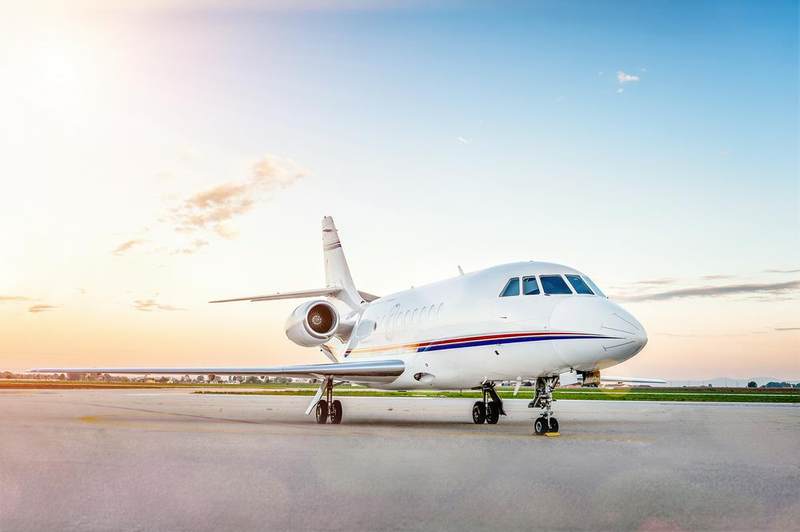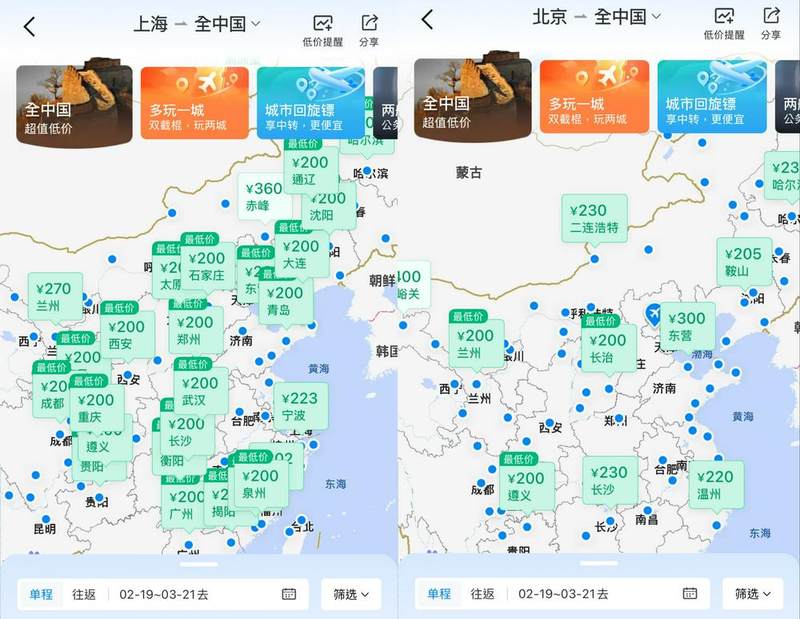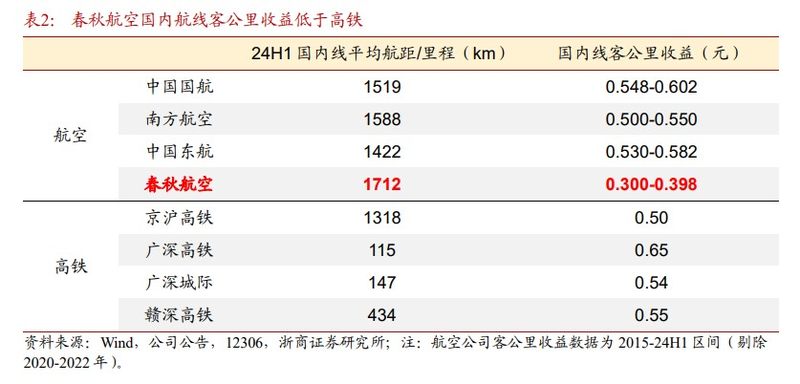What is the pricing logic for a 200-yuan ticket? Is it reasonable that air tickets are lower than high-speed rail tickets?
Airlines grab passengers at “low prices”: Air tickets are cheaper than high-speed rail, and ticket prices on some routes drop to 200 yuan after the holiday

Photo source: Visual China
Blue Whale News, February 20 (Reporter Sun Yu)The trend of low-cost air tickets has resurfaced, with naked prices on many popular routes falling to 200 yuan.
OTA platform data shows that from February 19 to March 21, flights departing from many popular cities all had tickets with a bare price of 200 yuan. Taking Beijing and Shanghai as examples, the naked price of air tickets to more than 20 cities across the country is less than 250 yuan, which is equivalent to about 10% off regular fare tickets. On many routes, plane fares are lower than high-speed rail fares.

Low-cost air tickets in Shanghai and Beijing; source: OTA platform
Taking the air ticket from Shanghai to Sanya as an example, the reporter inquired about the OTA platform and the official websites of major airlines. From February 24 to March 16, there were air tickets with a bare price of 200 yuan. The airlines in charge include China Eastern Airlines, China Southern Airlines, Hainan Airlines, Spring and Autumn, Jixiang, etc.
What is the pricing logic for a 200-yuan ticket? Is it reasonable that air tickets are lower than high-speed rail tickets?
Some airlines have lower single-kilometer fares than high-speed rail
Zheshang Securities pointed out in a research report released on January 7 this year that Spring Airlines, as the domestic leader in low-cost aviation, has a significantly lower ticket per kilometer than high-speed rail. Data shows that the single-kilometer fare range for Spring Airlines domestic routes from 2015 to 2024H1 is 0.300-0.398 yuan (excluding 2020-2022), and the single-kilometer fare for the second-class seat of the Beijing-Shanghai high-speed railway is about 0.5 yuan.
In fact, the phenomenon that the ticket price per kilometer is lower than that of the high-speed rail is not unique to Spring Airlines. The reporter reviewed the 2024 semi-annual reports of major airlines and found that the decline in passenger mile revenue is a common feature in the industry, and the price cuts of the three major airlines exceed those of the two low-cost airlines, Chunqiu and Jixiang.
Among them, Air China’s passenger kilometer revenue was 0.54 yuan, a year-on-year decrease of 12.08%; China Eastern Airlines ‘passenger kilometer revenue was 0.526 yuan, a year-on-year decrease of 12.77%; China Southern Airlines’ passenger kilometer revenue was 0.49 yuan, a year-on-year decrease of 12.50%; Spring Airlines ‘passenger kilometer revenue was 0.393 yuan, a year-on-year decrease of 1.75%; Jixiang Airlines’ passenger kilometer revenue was 0.47 yuan, a year-on-year decrease of 6%.
Comparing the passenger kilometer revenue data of high-speed rail, the Beijing-Shanghai high-speed rail is 0.50 yuan, the Guangzhou-Shenzhen high-speed rail is 0.65 yuan, and the Ganxi-Shenzhen high-speed rail is 0.55 yuan. The passenger kilometer revenue data of many airlines are even lower.

Comparison of passenger kilometer revenue between aviation and high-speed rail; Source: Zheshang Securities
Behind the low-priced air tickets is the wrestling between market supply and demand. A civil aviation staff member told reporters: When the load factor of flights is low, airlines often take price reduction measures to attract more passengers. In addition, most passengers like to book tickets through the OTA platform. The ticket prices of major airlines are clear at a glance, and low-priced tickets are more competitive. rdquo;
Data from Zheshang Securities Research Institute shows that during the period from January to November 2024, the fleet recovery rate was better than the passenger flow recovery rate during many periods. China Eastern Airlines also previously pointed out in its 2024 semi-annual report that the daily utilization rate of aircraft has not recovered to the level of the same period in 2019.& ldquo; The civil aviation market has excessive capacity and supply exceeds demand, so fares will naturally come down. rdquo;
Judging from the cost structure of a flight, the reporter inquired about the financial reports of several airlines and found that fuel costs accounted for about 35%, take-off and shutdown service fees accounted for about 12%, depreciation and amortization accounted for about 17%, and employee salaries accounted for about 16%, aircraft maintenance and repair fees accounted for about 7%. The total of the above expenses accounted for about 87% of operating costs, which are fixed costs and are not affected by the passenger load factor.
“An extra passenger means an extra in-flight catering fee for an airline. This cost has little impact on the airline. Even if the overall catering fee is viewed, the proportion is basically no more than 3%, and the catering fee for a passenger can be ignored.” rdquo; Industry insiders pointed out.
Major airlines cut prices to grab passengers”
Along with the heated discussion on the price of a 200-yuan ticket, there was also recent news that airlines were interviewed, saying that they were not allowed to sell tickets below 200 yuan. Blue Whale reporters called the customer service service of several airlines to understand the situation, but did not receive clear information. The customer service said that the official website information should prevail.
According to interface news, some marketers from large domestic airlines said that the civil aviation industry is market-oriented management, not public transportation. The lower price limit has not been clearly required. However, when the price war among airlines is serious, the Civil Aviation Administration will step in to make adjustments.
The emergence of low-cost air tickets is a battle between airlines to attract passengers in line with passengers ‘pursuit ofcost-effectiveness.
In recent years, the profitability of low-cost airlines, represented by Spring and Autumn and Jixiang, has become prominent. As of now, the two airlines have not announced their full-year performance forecasts for 2024, but data from the third quarterly report shows that Spring Airlines ‘net profit for the first three quarters of 2024 is 2.604 billion yuan, and Jixiang Airlines’ net profit for the first three quarters of 2024 is 1.271 billion yuan.
In contrast, Air China, China Eastern Airlines, and China Southern Airlines are still at a loss. The load factor of the three major airlines is lower than that of the two low-cost airlines, Spring and Autumn and Jixiang, so exchanging price for volume has become an inevitable choice.
In terms of implementation, price cuts have indeed promoted the growth of passenger numbers. Compared with the data for the first half of 2024, the number of passengers of Air China and China Eastern Airlines increased by 34.95% and 30.41% respectively year-on-year, which is higher than the growth rate of 27.59% in the Spring and Autumn Period, and also higher than the 18.50% year-on-year passenger growth.
From the perspective of passenger load factor, in the first half of 2024, Spring Airlines ‘passenger load factor was as high as 91.31%, a year-on-year increase of 3.36%; Junxiang Airlines was 84.51%, a year-on-year increase of 3.83%; Air China was 79.29%; a year-on-year increase of 8.77%; China Eastern Airlines was 81.21%; a year-on-year increase of 9.44%; China Southern Airlines was 83.07%, a year-on-year increase of 7.30%.
Civil aviation analysts pointed out that the room for improvement in the future passenger load factor of the three major airlines has also become the driving force for further price wars. In addition, from the perspective of daily aircraft utilization, taking Air China as an example, the 2024 semi-annual report data shows that the daily aircraft utilization rate is 8.79 hours, the spring and autumn period is 9.28 hours, and the auspicious period is 11.47 hours. Air China also has room for further improvement.
Some civil aviation people pointed out the dilemma behind the price reduction of air tickets. It is easy to reduce air tickets, but the aviation fuel, take-off and landing, and maintenance costs of many airlines are on the rise, putting pressure on airline performance.
The China Aviation Association previously mentioned at the communication meeting that the air passenger transport market will be prosperous and not prosperous in 2024. The civil aviation industry will transport 730 million passengers in 2024, a year-on-year increase of 17.9%. However, the average revenue level of passenger kilometers However, the level of passenger kilometers dropped by 12.5% year-on-year.
Low-priced tickets or a gimmick to attract tourists?
In fact, to a certain extent, low-cost air tickets are just a gimmick to attract passengers. Low-cost tickets are often accompanied by conditions such as no baggage check-in quota, limited refunds and changes, and some seat choices also require additional payment. In addition, in-flight shopping, airport shopping, etc. are not included in the ticket price, which bring additional revenue to airlines.
The increase in passenger flow caused by the airline price war has actually benefited major airports. The growth of passengers has driven the growth of airport merchandise sales revenue.
The Shanghai Airport announcement shows that the company expects to achieve net profit attributable to shareholders of listed companies in 2024 of 1.86 billion yuan to 2.055 billion yuan, a year-on-year increase of 99.13% to 120.01%. It mentioned that the passenger throughput exceeded 124 million passengers, a record high.
Baiyun Airport expects to achieve a net profit attributable to owners of the parent company of 832 million yuan to 1.017 billion yuan in 2024, a year-on-year increase of 88.39% to 130.25%. Shenzhen Airport announced that net profit attributable to shareholders of listed companies in 2024 is expected to be 399 million yuan to 444 million yuan, a year-on-year increase of 0.78% to 11.88%.
It is worth mentioning that air ticket prices may fall, but fuel surcharges on domestic routes have begun to increase. A number of airlines have issued notices stating that starting from February 5, 2025 (the date of issue), fuel surcharges on domestic routes will be increased. Among them, adult passengers: a fuel surcharge of 40 yuan will be charged for each passenger on routes above 800 kilometers, and a fuel surcharge of 20 yuan will be charged for each passenger on the following routes.
Some civil aviation sources told Blue Whale News that air travel requires costs, and too low prices are not conducive to the sustainability of services. As a high-cost and asset-heavy industry, the air transport industry has a procurement cost of about 500 million yuan for a single narrow-body passenger plane, and the aircraft age is about 20 years. It takes 7-10 years to train a qualified pilot, and the investment cost exceeds 2 million yuan.
“This is essentially a test of the airline’s value management capabilities. It must not only dilute unit costs through scale effects, but also avoid falling into the death spiral of low price-cost reduction-inferior quality-lower price. When air ticket prices fall below the benchmark of aviation displacement value, the sustainable development of the entire air transport system will face fundamental challenges. rdquo;


